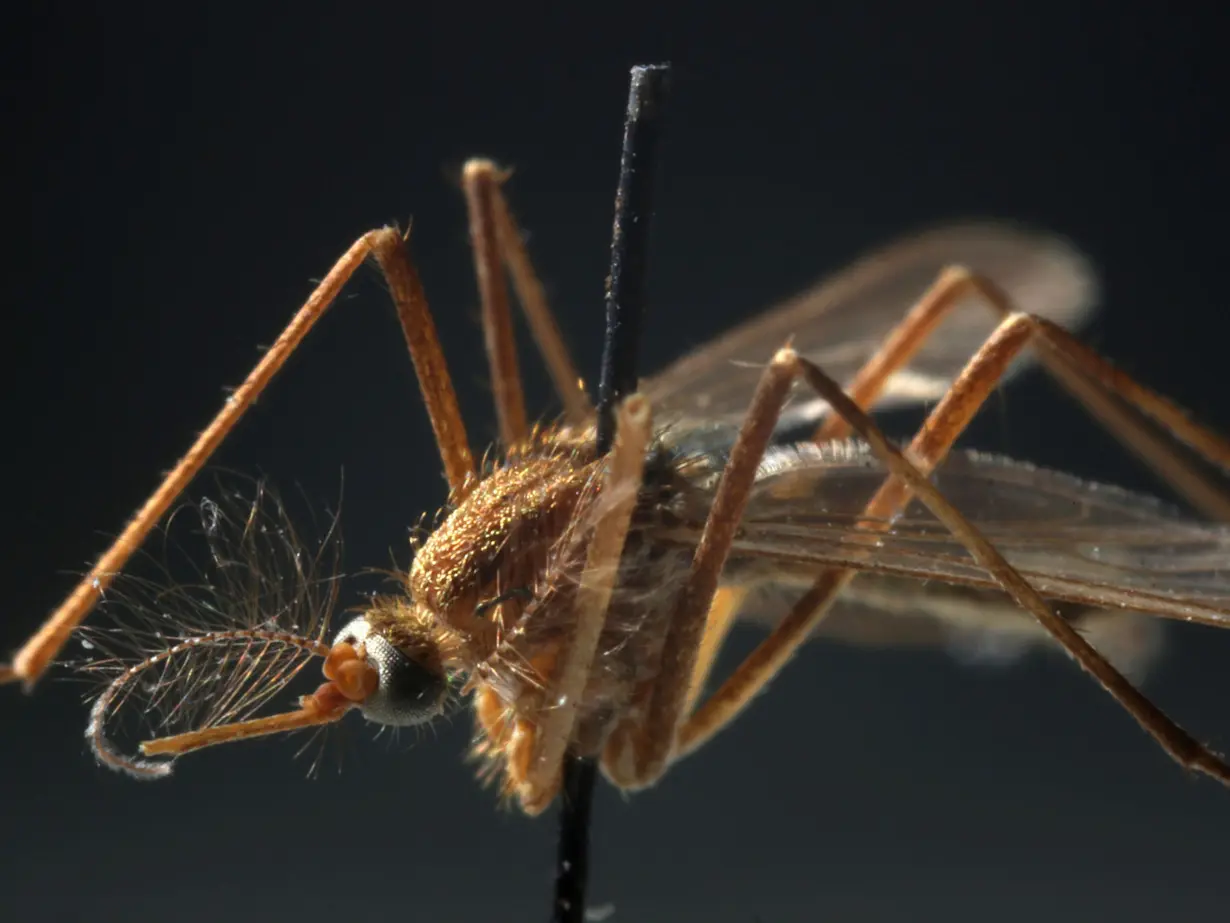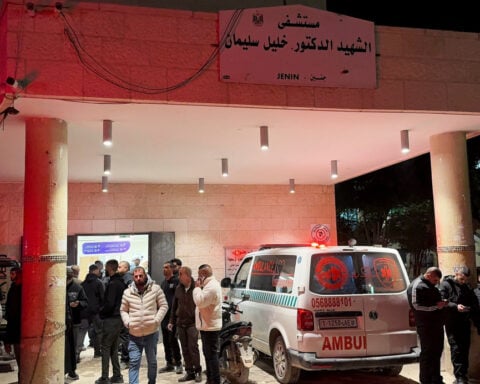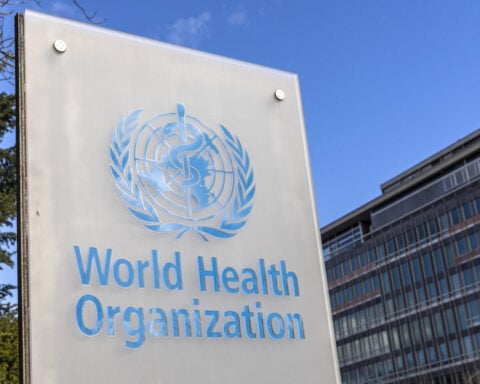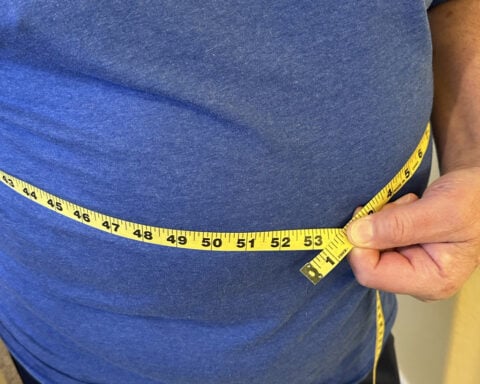(CNN) — Brittany Yeager was leading a troop of girls at Girl Scout camp in Idaho last summer when a mosquito bite upended her life.
Once a runner, hiker and math wiz, Yeager, 30, now takes 23 pills a day to manage symptoms that include paralysis, pain, seizures, muscle spasms, depression and memory problems. She recently learned to stand again and take a few steps, but she relies on an electric wheelchair to get around. She leans on her husband and in-laws to help her take care of her two children: a 7-year-old son and a daughter who is 10.
Her daughter in particular struggles with anxiety about being outdoors near mosquitoes after seeing what happened to her mom.
“We had to go through a lot of trauma to get her just to go back to camp this year,” said Yeager’s mother, Kisstina Streby.
John Brittingham, 67, was demolishing a deck in his backyard in Santa Fe, New Mexico, when he was bitten. Ten months later, after rehab and physical therapy, he’s still in the hospital, fighting every day to get his body to function again. He was recently weaned off a ventilator a second time, and his wife hopes this marks the start of a sustained recovery.
Jule Hamrick, now 62, was sitting in her backyard in Roswell, Georgia, when she first noticed that a mosquito bite had raised an itchy welt on her ankle.
“I was like everyone else that, when you heard West Nile, it was either like the flu or you die. There was no in-between,” she said. “There wasn’t the story of what happened to me.”
Yeager, Brittingham and Hamrick are three of the roughly 1,000 Americans who are hospitalized each year with the most severe form of West Nile virus, in which the infection invades the brain and nervous system. Another 1,500 people, on average, are diagnosed with the mosquito-borne disease after they develop a flu-like illness with fever and a rash.
These may not sound like big numbers, but experts agree that the 2,500 or so reported cases each year represent the tip of a much bigger iceberg.
“It’s like rain in a rain gauge. It doesn’t capture all the drops; it just gives you trends,” said Dr. Ben Beard, principal deputy director of the US Centers for Disease Control and Prevention’s Division of Vector-Borne Diseases.
Most West Nile cases are mild, causing flu-like symptoms and a rash. Because symptoms of the infection are not specific and most people recover without treatment, experts estimate that as many as 80% of infections in the US are never caught or counted.
A study published in April in the journal Viruses that looked for evidence of past infection in the stored blood of 250 people admitted to the hospital for other reasons found that almost 1 out of every 5 samples had antibodies to West Nile virus.
“It was definitely higher than previously suspected,” said lead study author Emma Underwood, who is studying for a Ph.D. in public health at the University of South Florida, in Tampa. If that percentage were applied to the entire population of Hillsborough County, Florida, “that’s almost a quarter of a million people who have been bitten by an infected mosquito and infected.”
This year, West Nile activity has picked up earlier than usual–the heaviest activity is typically seen in August and September– and experts are worried that could mean a blockbuster year for the virus.
“There’s a lot of activity now happening in the country,” said Dr. Kristy Murray, a professor and executive vice chair for research at Emory University in Atlanta.
Murray was part of the team of CDC disease detectives dispatched to solve a cluster of unexplained encephalitis, or brain swelling, cases in New York City in 1999. Those patients turned out to have the first cases of West Nile virus in the US.
In the 25 years that she and other public health officials have tracked it, they’ve seen large spikes in West Nile activity roughly every 10 years, which scientists believe is tied to when large populations of birds lose immunity to the virus. Mosquitoes pick up the virus when they feed on infected birds.
The last big jump in cases was in 2012.
“I think we’re at our time where we’re due for an outbreak,” Murray said.
Murray expects that Houston and the surrounding area will be a particular hotspot because of this month’s Hurricane Beryl. So far, seven human cases of West Nile infection have been reported in Harris County, Tex., about one-sixth of all the cases reported in the US so far this year.
Dr. Max Vigilant, director of mosquito control for Harris County Public Health in Texas, says his department has seen more than 500 pooled samples of mosquitoes test positive for the virus this year. Only 50 pools tested positive for all of last year.
“It is hot and humid, and it is the perfect condition for the virus to thrive,” he wrote in an email.
Even milder cases that go undetected can still be consequential.
“We still see people – even when they’re younger and otherwise had a milder case – we’ve actually seen that they can develop neurological issues over time,” Murray said. “So kind of like what you see with long Covid, we’ve seen that with West Nile as well, where you can get this ‘long West Nile’ kind of picture.”
Watching West Nile patients struggle to recover from their infections made Murray wonder what would become of survivors over time. Early in her career, she started the Houston West Nile Cohort, a project she still runs today.
That registry has followed more than 350 participants for at least 15 years, making it the largest and longest-running collection of West Nile patients in the US. Most of what’s known about the virus comes from studies of their recoveries.
About 1 in 5 people who are infected with get a fever and flu-like symptoms, including headache, eye pain, fatigue, and muscle and joint pain. They may also have a rash. About 1 in 150 cases will develop neuroinvasive disease, which can cause brain swelling, brain damage and death. About 100 people die from West Nile infections in the US annually.
Survivors face a long and difficult recovery
Yeager, who lives in Kennewick, Washington, says that before she caught it, the only thing she knew about West Nile virus was what she remembers reading in her high school textbooks. She thought only people who traveled outside the US needed to worry about catching it.
When she took her daughter’s Girl Scout troop to Camp Four Echoes in Idaho last summer, she reminded the girls to wear bug spray. She did too, but after a swim, she found mosquito bites on her lower back, where her swimsuit left exposed skin.
A few days after she returned from camp, she started having trouble moving her right arm. An urgent care doctor thought she might have compressed nerves in her neck and prescribed physical therapy. She started going right away, but the paralysis only got worse.
During a boat trip, her mom noticed that Yeager, a former lifeguard, was having trouble swimming. The next day, her entire right side was paralyzed, and her mother, a nurse, insisted that she go to the ER.
At the hospital, doctors found no signs of a stroke or a brain tumor, so they diagnosed her with Bell’s palsy, a condition that causes sudden paralysis on one side of a person’s face. It’s thought to be caused by damaged or inflamed nerves.
As her condition worsened, it became clear that it wasn’t Bell’s palsy, either. Her speech was soon affected, and she began to have intense headaches. Doctors at another hospital thought she could have some kind of complex headache syndrome. They took a sample of her spinal fluid and sent her home, unable to fully explain what was happening to her.
She only got worse. “By this time, she’s just not functioning,” said Streby, who helped answer questions on Yeager’s behalf because her daughter struggles to communicate. It can be difficult for her to find the words she wants to use and express her thoughts.
The paralysis had moved to both sides of Yeager’s body. She was losing her eyesight and confined to a wheelchair.
Late one night, worried and sleepless, her mother logged into Yeager’s electronic medical record and began reading lab results. She saw that Yeager’s spinal fluid had tested positive for West Nile two weeks earlier.
She called the doctor the next day. The hospital’s infectious disease specialist had notified the state of Yeager’s case, but somehow, no one had told her or her family.
At her next appointment, the physician spelled out the hard truth: There are no specific treatments for West Nile infection. All they could do was manage her symptoms with medication and physical therapy.
Stalled progress on vaccines and treatments
Over the years, scientists have developed promising vaccine candidates against West Nile virus. Several have been approved for use in horses, which also may become gravely ill after catching the infection from a mosquito, but there are no such shots available to protect people.
Dr. Erin Staples, a medical epidemiologist in the CDC’s Division of Vector-Borne Diseases, said some vaccine candidates for people have progressed as far as the second phase of human trials, but none has made it to a larger phase 3 study, which would be necessary for licensure by the US Food and Drug Administration.
Traditionally, a phase 3 trial depends on enrolling a large group of people, giving half the vaccine and half a placebo shot, and comparing rates of infections between the two groups.
West Nile is unpredictable, however, which makes it difficult to execute that kind of study in a timely fashion.
“We don’t know, from this year to next year to the following year, where there will be enough cases or a large enough outbreak for that classic phase 3 trial to be completed,” Staples said.
There have also been questions about safety. Several of the vaccine candidates are live but weakened versions of the virus, and there have been concerns that these vaccines might be too risky to use in people with reduced immune function, such as elderly adults.
Finally, companies have cited the cost of developing and marketing a vaccine for West Nile when awareness of the infection is low.
In a recent commentary in the New England Journal of Medicine, Staples and her CDC co-authors showed examples of other vaccines that have been developed for severe diseases, despite each of these hurdles.
A new vaccine against chikungunya disease, for example, which is also spread by mosquitoes, was licensed in the US in February after demonstrating robust immunity in primates.
Like West Nile, chikungunya is cagey. After a spate of locally acquired infections in the US in 2014, the virus went into hiding. There haven’t been any locally acquired cases in the US since 2019, which made it nearly impossible to test a vaccine in humans.
Animal models, however, gave regulators enough information to greenlight the shot so it will be ready in case there’s another outbreak, Staples said.
She thinks the same approach could be used to secure approval for a West Nile Vaccine.
Staples said that if the vaccine were targeted to high-risk groups in areas seeing heightened disease activity, it would be a cost-effective strategy that would save lives.
“If we do that approach, we could actually be preventing up to 60 percent of all West Nile virus disease cases in the United States annually, as well as a third of the deaths,” she said.
Doctors have also tried to develop monoclonal antibodies to help people clear the infection, similar to the kind of antibodies that were used to help high-risk Covid patients during the pandemic.
Murray says the researchers working on those treatments ran into the same problem mounting a large-scale clinical trial, and so there’s still no specific therapy or antiviral to help people once they are infected.
“It’s been one of the things that’s most frustrating for me,” she said. “We don’t have any kind of treatment, any kind of antiviral, any kind of option, really, to treat West Nile cases right now.”
Taking life one day at a time
Yeager is slowly making progress relearning how to walk. She has recently been able to stand and take a few steps, although she still spends a lot of time in a wheelchair. She has exhausted the home health care that’s covered by her insurance and has applied for government disability benefits.
The loss of her income has been a hardship , and her family set up a Go Fund Me page to help pay their mounting medical bills.
Her mini-me daughter, Charlie, has become especially anxious about going outside and being bitten by bugs, but her mom has tried to explain that what happened to her was a very rare thing.
Yeager went back to Camp Four Echoes in her wheelchair recently to help teach the girls about her condition and show her daughter that she wasn’t afraid to return.
“Facts and numbers are my specialty, and I know the chances are slim,” Yeager said. “She’s 10. She doesn’t know percents, so she’s scared.”
Still, she admits that it was hard for her to let Charlie return to camp this year.
“I kept that worry close to my vest,” she said. “I want her to have adventures, and the idea that a bug can change your life at any time, I don’t want her to think of those things quite yet.”
Trouble where you least expect it
Brittingham was two years into his retirement in Santa Fe when he took on a home improvement project: tearing down a deck on the back of his house.
When he later felt unwell and went to urgent care, doctors suspected that the demolition may have exposed him to a different animal-borne disease, hantavirus, through rodent droppings.
Nobody suspected mosquitoes in Santa Fe’s arid climate.
“The weirdest symptom was that he couldn’t walk. Almost like you went on a steep hike and your calves were really sore, but his was more of an act of shuffling,” said his wife, Heather.
Doctors couldn’t figure it out, either. They told him to come back if he got worse.
“That weekend, he just deteriorated,” Heather said.
John lost all control of his muscles, and Heather called an ambulance. At the hospital, he lost the ability to breathe on his own.
“I will probably always have a little PTSD from hearing ‘code blue’ outside the hospital room, Heather said.
John was intubated and hooked up to a machine to take over his breathing while doctors worked to figure out what was wrong.
A relative who is an infectious disease doctor kept in close touch and worked with John’s medical team to search for answers. Finally, they tested his spinal fluid. It was positive for West Nile.
The diagnosis gave them the comfort of having a reason for what was happening, but it didn’t do much to change John’s care. All they could do, they were told, is watch and wait.
They were transferred to Albuquerque and then to rehab in Chicago, where John was able to be weaned off a ventilator and started to use his arms and legs again.
When they ran out of insurance coverage for his stay, however, John was transferred to a long-term care facility in Houston, and he lost a lot of the progress he’d made, Heather said. He had to go back on a ventilator.
Watching her husband backslide was devastating, Heather said. She appealed to the hospital CEO for help. John was transferred again, this time to the main hospital, and doctors again have started trying things to help him recover from his infection.
John has recently come off the ventilator again, and Heather hopes this time will be a turning point that will help them get back home.
“I can’t even believe we’re here,” she said. “I haven’t been home for nine months because of a mosquito bite.”
A new normal
Hamrick was talking on the phone in her backyard and absentmindedly scratching her foot when she realized she’d scratched a mosquito bite hard enough to make it bleed. A few days later, she began to feel unwell at a college football tailgate.
At first, she thought she had a sinus infection, and then maybe a migraine. Whatever it was, it continued to get worse.
Within a few days, she was in the hospital on a ventilator, paralyzed from the waist up.
She went to two hospitals before a doctor tested her spinal fluid and discovered that she had West Nile virus.
“You’re gonna be OK,” her husband whispered in her ear. “They know what it is. It’s West Nile.”
In their minds, Hamrick said, West Nile was something you could get over, unless you were very old or in poor health before you got it. At age 57, she was neither of those things.
“I call it reverse ALS, because I started off where ALS patients end: couldn’t breathe, couldn’t move, hospitalized and on a ventilator,” she said.
She fought her way back with physical and occupational therapy, and six years later, she’s proud of her progress. She’s learned how to walk again and doesn’t need a wheelchair anymore, but she still can’t raise her arms, which means she can’t dress herself or drive.
Murray says that in the Houston West Nile Cohort, most people who had infections that invaded their brains, like Hamrick and Yeager, don’t return to the way they were before.
“Eighty percent of encephalitis cases never returned to their baseline status,” Murray said. “A majority of recovery occurs in the first two years, and basically, wherever you are at the two-year mark is what we were seeing long-term.”
Even people who have milder illness – those with a fever and flu-like symptoms – may wind up with lasting damage to their brains.
Murray gave participants brain scans when joined the West Nile cohort and then did follow-up neurological exams nine years later. What she found surprised her.
“Over that time period, we saw progression of neurologic disease – not improvement – even in people who had these milder West Nile fever cases,” she said.
Protection starts with awareness
Thousands of Americans will become ill during West Nile season, which begins in the summer and runs through fall, with over 1,000 cases of serious illness and more than 100 deaths, which makes protecting yourself against mosquito bites your best line of defense, said the CDC’s Staples.
“Use your insect repellent. I have a can at my front door and my back door, so I don’t go through that door without putting it on,” she said.
The CDC advises choosing a repellant with one of six active ingredients:
- DEET
- Picaridin
- Oil of lemon eucalyptus
- IR3535
- Para-menthane-diol (PMD)
- 2-undecanone
These have all proved to be safe and effective at repelling mosquitoes, even for pregnant and breastfeeding moms.
Wearing long pants and long sleeves when you go outdoors can also help.
It’s also smart to check with your local health department to see whether West Nile virus has been detected in mosquitoes or birds in your area.
The CDC keeps maps of where West Nile cases have been detected in the United States. This year, human infections have been reported across 19 states.
The species of mosquitoes that are the main carriers of West Nile virus are especially active at dawn and dusk, so it’s particularly important to take precautions then.
“I don’t think anybody – doctors included – realize what that one mosquito can do,” Hamrick said.
The-CNN-Wire
™ & © 2024 Cable News Network, Inc., a Warner Bros. Discovery Company. All rights reserved.

 India's navy launches submarine, warships to guard against China's presence in Indian Ocean
India's navy launches submarine, warships to guard against China's presence in Indian Ocean
 UK inflation unexpectedly eases in December, which could reduce pressure in bond markets
UK inflation unexpectedly eases in December, which could reduce pressure in bond markets
 Body count from South African mine siege rises to 60
Body count from South African mine siege rises to 60
 Question on ASEAN stumped Hegseth at Senate hearing. What is it and why is it important?
Question on ASEAN stumped Hegseth at Senate hearing. What is it and why is it important?
 US importers rush in goods from China as Trump tariff threat looms
US importers rush in goods from China as Trump tariff threat looms
 Novak Djokovic breaks a tie with Roger Federer for the most Grand Slam matches in tennis history
Novak Djokovic breaks a tie with Roger Federer for the most Grand Slam matches in tennis history
 China's RedNote: what you need to know about the app TikTok users are flocking to
China's RedNote: what you need to know about the app TikTok users are flocking to
 British author Neil Gaiman denies ever engaging in non-consensual sex as more accusers come forward
British author Neil Gaiman denies ever engaging in non-consensual sex as more accusers come forward








